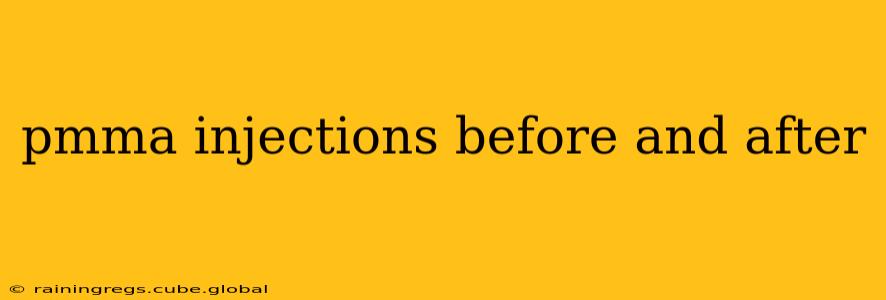Polymethyl methacrylate (PMMA), also known as Artefill, is a permanent filler used in cosmetic procedures to augment facial features and improve skin texture. This comprehensive guide delves into what you can expect before, during, and after PMMA injections, addressing common questions and concerns. We'll explore the potential benefits, risks, and the recovery process to help you make an informed decision.
What are PMMA Injections Used For?
PMMA injections are primarily used for facial rejuvenation. Common applications include:
- Facial wrinkles and lines: PMMA can effectively fill deep wrinkles and folds, such as nasolabial folds (the lines running from the nose to the corners of the mouth) and marionette lines (the lines that run from the corners of the mouth down towards the chin).
- Lip augmentation: Adding volume to the lips to enhance their shape and fullness.
- Cheek augmentation: Restoring lost volume in the cheeks for a more youthful appearance.
- Scar treatment: Improving the appearance of atrophic (sunken) scars.
- Hand rejuvenation: Filling in volume loss in the hands to reduce the appearance of aging.
What Happens Before PMMA Injections?
Before undergoing PMMA injections, you'll have a thorough consultation with a qualified and experienced dermatologist or plastic surgeon. This consultation is crucial. Expect to discuss:
- Your medical history: This includes any allergies, medications you're taking, and previous medical procedures.
- Your aesthetic goals: Clearly communicating your desired outcome helps the practitioner tailor the treatment plan to meet your specific needs.
- Potential risks and complications: A detailed explanation of the possible side effects and potential complications of the procedure will be provided.
- Pre-procedure instructions: You will receive specific instructions, potentially including avoiding certain medications or supplements before the procedure.
What to Expect During PMMA Injections?
The procedure itself is relatively straightforward. The practitioner will:
- Cleanse the treatment area: To ensure a sterile environment and minimize the risk of infection.
- Administer the PMMA: Using a fine needle, the PMMA is injected into the targeted areas. The injection process may feel slightly uncomfortable, but most patients tolerate it well. Numbing cream can be applied beforehand to minimize discomfort.
- Massage the area: Gentle massage helps to evenly distribute the PMMA.
PMMA Injections: Before & After Photos – What Can I Expect?
The results of PMMA injections are long-lasting. You should see an improvement in the treated area immediately after the procedure. However, full results may take several weeks or even months to fully manifest as the body integrates the PMMA. Before & After pictures showcased by reputable clinics and surgeons can be a valuable tool to understand potential results, but remember that individual results vary. Remember to discuss realistic expectations with your doctor.
What is the Recovery Process Like After PMMA Injections?
Recovery is generally minimal. You can usually return to your normal activities immediately after the procedure. However, you might experience some:
- Mild swelling and bruising: This is temporary and usually subsides within a few days.
- Redness and tenderness: These symptoms are also typically short-lived.
- Minor discomfort: Over-the-counter pain relievers can help manage any discomfort.
It's crucial to follow your practitioner's aftercare instructions diligently to ensure optimal healing and reduce the risk of complications.
What are the Possible Risks and Side Effects of PMMA Injections?
While generally safe, PMMA injections carry some potential risks, including:
- Infection: As with any injection, there's a small risk of infection.
- Nodules or lumps: These are relatively rare but can occur if the PMMA isn't injected correctly.
- Allergic reactions: Although rare, allergic reactions can occur.
- Vascular occlusion: This is a serious complication where the PMMA blocks blood vessels, potentially causing tissue damage. This risk is significantly reduced with proper technique and experience by a qualified injector.
Are PMMA Injections Permanent?
Yes, PMMA injections are considered a permanent filler. The PMMA particles remain in the injected area, providing long-lasting results.
How Much Do PMMA Injections Cost?
The cost of PMMA injections varies depending on several factors, including the area treated, the amount of PMMA used, and the practitioner's fees.
How Long Do the Results of PMMA Injections Last?
Since PMMA is a permanent filler, the results are essentially lifelong.
How Can I Find a Qualified Practitioner for PMMA Injections?
It's essential to choose a qualified and experienced dermatologist or plastic surgeon who specializes in facial injectables. Look for board-certified practitioners with a proven track record and a strong understanding of facial anatomy. Check reviews and testimonials from previous patients.
This information is for general knowledge and does not constitute medical advice. Always consult with a qualified healthcare professional before undergoing any cosmetic procedure.
